How to Read Txt Files in R
In this tutorial, we will learn how to work with Excel files in R statistical programming environment. It will provide an overview of how to utilise R to load xlsx files and write spreadsheets to Excel.
In the first section, we will go through, with examples, how to use R read an Excel file. More specifically, we are going to learn how to;
- read specific columns from a spreadsheet ,
- import multiple spreadsheets and combine them to one dataframe,
- read many Excel files,
- import Excel datasets using RStudio
Furthermore, in the last part nosotros are going to focus on how to export dataframes to Excel files. More specifically, we are going to larn how to write;
- Excel files, rename the sheet
- to multiple sheets,
- multiple dataframes to a Excel file
How to Install R Packages
At present, before we go on with this Excel in R tutorial we are going to acquire how to install the needed packages. In this mail, we are going to use tidyverses readxl and the xlsx parcel to read xlsx files to dataframes.
Note, we are mainly using xlsx, in this post, considering readxl cannot write Excel files, simply import them into R.
# Install tidyverse install.packages("tidyverse") # or just readxl install.packages("readxl") # how to install xlsx install.packages("xlsx")
Code language: R ( r ) Now, Tidyverse comes with a lot of useful packages. For example, using the package dplyr (part of Tidyverse) y'all tin can remove duplicates in R, and rename a column in R's dataframe.
How to install RStudio
In the terminal instance, we are going to read xlsx files in R using the interactive development environment RStudio. Now, RStudio is quite piece of cake to install. In this post, we volition cover two methods for installing RStudio.
Here's 2 steps for installing RStudio:
- Download RStudio hither
- Click on the installation file and follow the instructions
At present, there'due south another selection to become both R statistical programming environment and the great general-purpose language of Python. That is, to install the Anaconda Python distribution.
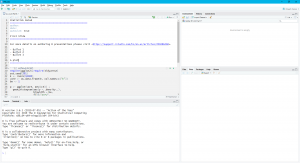
Note, RStudio is a corking Integrated Development Environment for carrying out data visualization and assay using R. RStudio is mainly for R but we tin also use other programming languages ( e.g., Python). That is, we typically don't use RStudio for importing xlsx files only.
How to Read Excel Files to R Dataframes
Tin R read xlsx files? In this section, nosotros are going to discover out that the answer is, of course, "yep". We are going to learn how to load Excel files using Tidyverse (e.g., readxl).
More specifically, in this department, we are going to learn how to read Excel files and spreadsheets to dataframes in R. In the read Excel examples nosotros will read xlsx files from both the hard drive and URLs.
How to Import an Excel file in R using read_excel
First, we are going to load the r-package(due south) nosotros need. How do I load a package in R? It tin can be washed either by using the library or require functions. In the next code chunk, we are going to load readxl and then we tin can utilize the read_excel function to read Excel files into R dataframes.
require(readxl)
Code language: R ( r ) If nosotros wait at the documentation for the part, read_excel, that we are going to use in this tutorial nosotros can see that it takes a range of arguments.

Now information technology's fourth dimension to learn how to use read_excel to read in data from an Excel file. The easiest way to use this method is to pass the file name as a graphic symbol. If nosotros don't laissez passer any other parameters, such as canvass name, it will read the first canvas in the index. In the first instance we are not going to use whatever parameters:
df <- read_excel("example_sheets2.xlsx") head(df)
Code language: R ( r ) 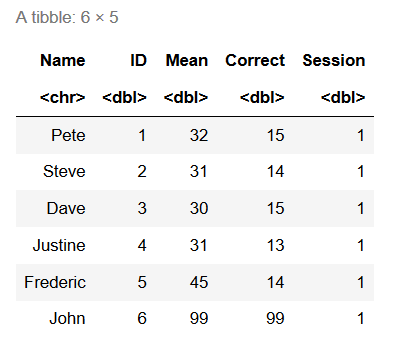
Here, the read_excel function reads the data from the Excel file into a tibble object. Nosotros can if nosotros desire to, alter this tibble to a dataframe.
Code language: R ( r )
df <- as.data.frame(df)
Now, after importing the data from the Excel file you can comport on with data manipulation if needed. It is, for instance, possible to remove a column, by name and alphabetize, with the R-packet dplyr. Furthermore, if you lot installed tidyverse yous will accept a lot of tools that enable you to practice descriptive statistics in R, and create scatter plots with ggplot2.
Importing an Excel File to R in Two Easy Steps:
Fourth dimension needed:1 infinitesimal.
Here's a quick answer to the question how do I import Excel information into R?? Importing an Excel file into an R dataframe only requires two steps, given that we know the path, or URL, to the Excel file:
- Load the readxl package
First, you blazon library(readxl) in east.g. your R-script
- Import the XLSX file
Second, you tin use read_excel office to load the .xlsx (or .xls) file
We at present know how to easily load an Excel file in R and can continue with learning more near the read_excel function.
Reading Specific Columns using read_excel
In this section, we are going to acquire how to read specific columns from an Excel file using R. Note, hither nosotros will besides use the read.xlsx function from the packet xlsx.

- How to use %in% in R: vii Instance Uses of the Operator
- Learn How to Transpose a Dataframe or Matrix in R with the t() Function
Loading Specific Columns using read_excel in R
In this department, nosotros are going to learn how to read certain columns from an Excel sheet using R. Reading merely some columns from an Excel canvas may be good if we, for case, have large xlsx files and we don't want to read all columns in the Excel file. When using readxl and the read_excel function we volition use the range parameter together with cell_cols.
When using read.xlsx, to import Excel in R, we can use the parameter colIndex to select specific columns from the sheet. For example, if want to create a dataframe with the columnsPlayer,Salary, andPosition, we tin accomplish this by calculation 1, three, and iv in a vector:
crave(xlsx) cols <- c(1, 2, 3) df <- read.xlsx('MLBPlayerSalaries.xlsx', sheetName='MLBPlayerSalaries', colIndex=cols) head(df)
Code language: R ( r ) 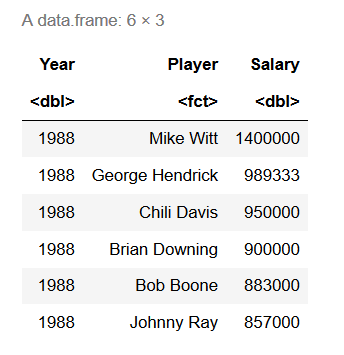
Handling Missing Data when we Import Excel File(due south) in R
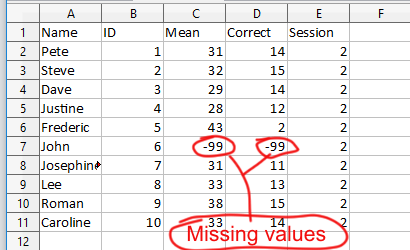
If someone has coded the data and used some kind of value to represent missing values in our dataset, we demand to tell r, and the read_excel function, what these values are. In the side by side, R read Excel case, we are going to use the na parameter of the read_excel function. Here "-99" is what is codes every bit missing values.
Read Excel Example with Missing Data
In the example below, we are using the parameter na and we are putting in a character (i.eastward., "-99"):
df <- read_excel('SimData/example_sheets2.xlsx', 'Session2', na = '-99') head(df, 6)
Code language: R ( r ) 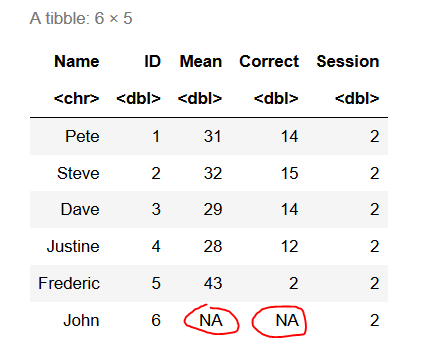
The example datasets we've used in the how to use R to read Excel files tutorial can be found here and here.
How to Skip Rows when Importing an xlsx File in R
In this department, we volition acquire how to skip rows when loading an Excel file into R. Hither'south a link to the example xlsx file.

In the post-obit, read xlsx in R examples nosotros are going to use both read_excel and read.xlsx to read a specific sheet. Furthermore, we are also going to skip the first 2 rows in the Excel file.
Skip Rows using read_excel
Here, we will utilise the parameter sheet and put the characters 'Session1' to read the canvass named 'Session1'. In a previous example, we just added the grapheme 'Session2' to read that sheet.
Note, the starting time canvas will be read if we don't use the sheet_name parameter. In this example, the important part is the parameterskiprow=2. We use this to skip the first two rows:
df <- read_excel('SimData/example_sheets.xlsx', sheet='Session1', skip = ii) head(df, iv)
Code linguistic communication: R ( r ) 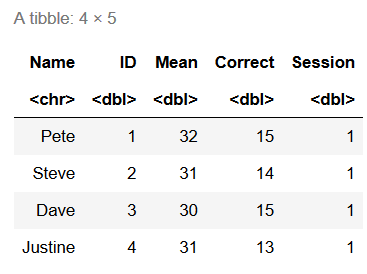
How to Skip Rows when Reading Excel Files in R using read.xlsx
When working with read.xlsx nosotros use the startRow parameter to skip the kickoff 2 rows in the Excel sheet.
df <- read.xlsx('SimData/example_sheets.xlsx', sheetName='Session1', startRow=3)
Code linguistic communication: HTML, XML ( xml ) Reading Multiple Excel Sheets in R
In this section of the R read excel tutorial, we are going to learn how to read multiple sheets into R dataframes.
In that location are ii sheets: 'Session1', and 'Session2, in the example xlsx file (example_sheets2.xlsx). In this file, each canvass has data from two experimental sessions.
We are now learning how to read multiple sheets using readxl. More specifically, nosotros are going to read the sheets 'Session1' and 'Session2'. Outset, we are going to employ the function excel_sheets to print the sheet names:
xlsx_data <- "SimData/example_sheets.xlsx" excel_sheets(path = xlsx_data)
Code language: R ( r ) 
Now if we want to read all the existing sheets in an Excel document we create a variable, called sheet_names.
After we have created this variable nosotros use the lapply part and loop through the listing of sheets, utilize the read_excel role, and end upwards with the list of dataframes (excel_sheets):
sheet_names <- excel_sheets(path = xlsx_data) excel_sheets <- lapply(sheet_names , function(10) read_excel(path = xlsx_data, sheet = x)) str(excel_sheets)
Lawmaking linguistic communication: R ( r ) 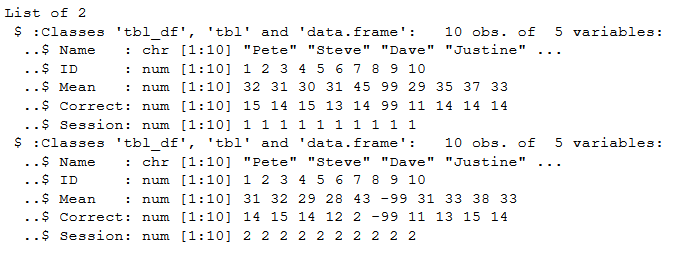
When working with Pandas read_excel due west may desire to bring together the data from all sheets (in this case sessions). Merging Pandas dataframes are quite piece of cake. We merely use the concat function and loop over the keys (i.e., sheets):
df <- do.call("rbind", excel_sheets) head(df)
Code language: R ( r ) 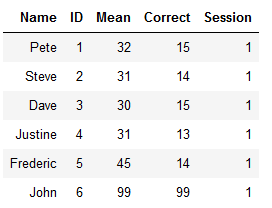
Once more, there might be other tasks that nosotros demand to carry out. For instance, we can also create dummy variables in R.
Reading Many Excel Files in R
In this section of the R read excel tutorial, we will learn how to load many files into an R dataframe.
For example, in some cases, we may have a bunch of Excel files containing data from different experiments or experimental sessions. In the next example, we are going to piece of work with read_excel, again, together with the lapply part.

However, this time we just take a grapheme vector with the file names and so we as well use the paste0 function to paste the subfolder where the files are.
xlsx_files <- c("example_concat.xlsx", "example_concat1.xlsx", "example_concat3.xlsx") dataframes <- lapply(xlsx_files, function(10) read_excel(path = paste0("simData/", x)))
Lawmaking language: R ( r ) Finally, nosotros use the do.call part, again, to bind the dataframes together to one. Annotation, if we want, we tin can likewise use, the bind_cols role from the r-package dplyr (part of tidyverse).
df <- practice.call("rbind", dataframes) tail(df)
Code language: R ( r ) 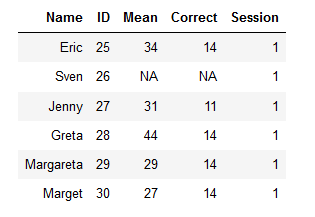
Note, if we want, nosotros tin also utilize, the bind_cols function from the r-parcel dplyr (function of tidyverse).
Code language: R ( r )
dplyr::bind_rows(dataframes)
Reading all Files in a Directory in R
In this section, we are going to larn how to read all xlsx files in a directory. Knowing this may come in handy if nosotros store every xlsx file in a folder and don't want to create a character vector, like above, by hand. In the next case, nosotros are going to apply R's Sys.glob function to get a grapheme vector of all Excel files.
xlsx_files <- Sys.glob('./simData/*.xlsx')
Code language: R ( r ) 
After nosotros have a character vector with all the file names that we want to import to R, nosotros just use lapply and practice.telephone call (run across previous lawmaking chunks).
Setting the Data type for information or columns
We tin can also, if we like, ready the data type for the columns. Let'southward utilize Pandas to read the example_sheets1.xlsx again. In the Pandas read_excel example beneath nosotros utilize the dtype parameter to gear up the information type of some of the columns.
df <- read_excel('SimData/example_sheets2.xlsx', col_types=c("text", "text", "numeric", "numeric", "text"), sheet='Session1') str(df)
Code language: R ( r ) 
Importing Excel Files in RStudio
Before we continue this Excel in R tutorial, we are going to larn how to load xlsx files to R using RStudio. This is quite simple, open up RStudio, click on the Environs tab (right in the IDE), and and so Import Dataset. That is, in this section, we volition answer the question of how do I import an Excel file into RStudio?
At present we'll go a dropdown menu and we can choose from unlike types of sources. Every bit we are going to piece of work with Excel files we choose "From Excel…":
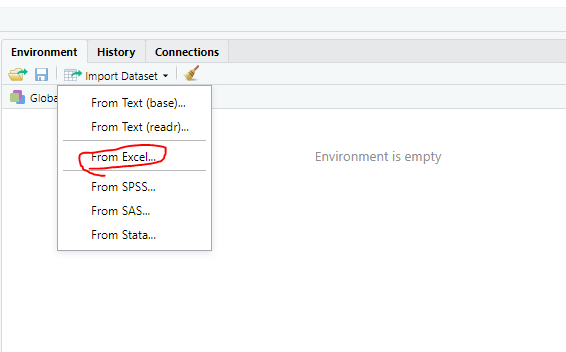
In the next step, we klick "Browse" and go to the folder where our Excel data is located.
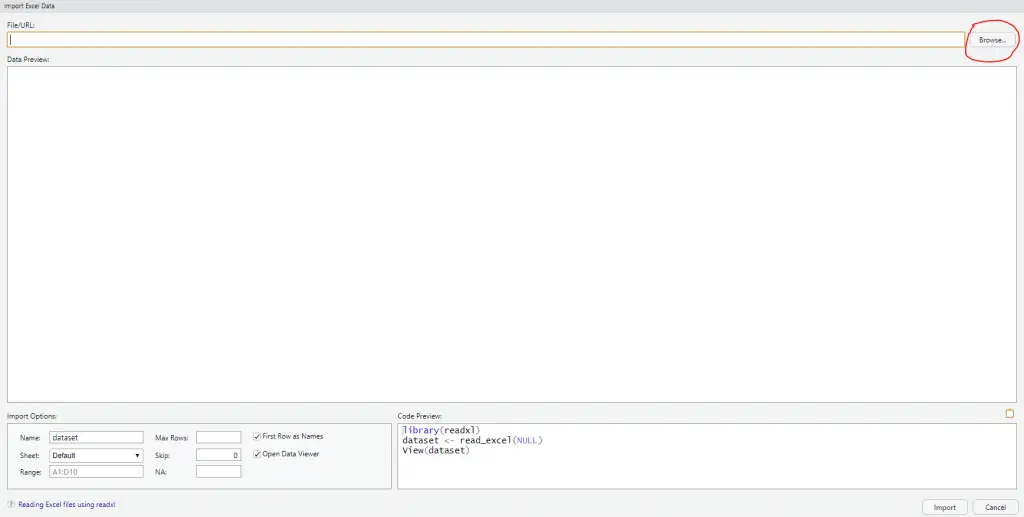
Now nosotros get some alternatives. For instance, we tin can modify the proper noun of the dataframe to "df", if nosotros want (see epitome below). Furthermore, before nosotros import the Excel file in RStudio we can also specify how the missing values are coded as well every bit rows to skip.
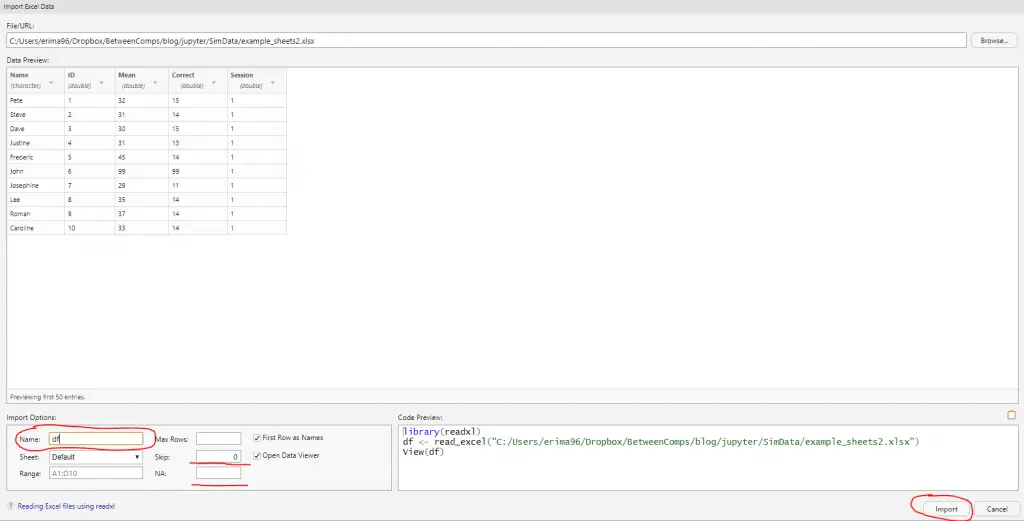
Finally, when nosotros have set everything every bit we desire we tin can hit the Import button in RStudio to read the datafile.
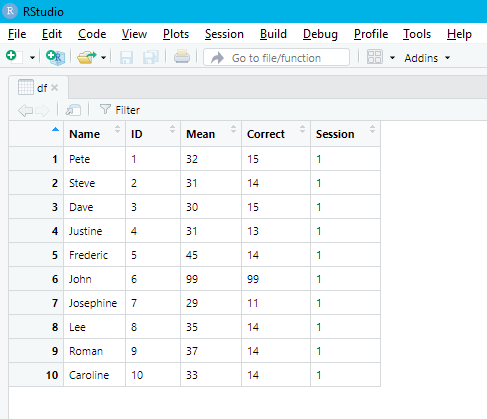
Writing R Dataframes to Excel
Excel files tin, of class, be created in R. In this section, we volition larn how to write an Excel file using R. As for now, nosotros have to use the r-package xlsx to write .xlsx files. More specifically, to write to an Excel file we volition use the write.xlsx office:

Nosotros will get-go by creating a dataframe with some variables.
df <- information.frame("Age" = c(21, 22, xx, 19, 18, 23), "Names" = c("Andreas", "George", "Steve", "Sarah", "Joanna", "Hanna")) str(df)
Lawmaking language: R ( r ) 
Now that we have a dataframe to write to xlsx we starting time by using the write.xlsx function from the xlsx parcel.
library(xlsx) write.xlsx(df, 'names_ages.xlsx', sheetName = "Sheet1"
Lawmaking language: R ( r ) In the output beneath the effect of not using whatsoever parameters is evident. If we don't use the parameter sheetName we go the default canvass name, 'Sheet1'.
As can be noted in the prototype below, the Excel file has cavalcade ('A') containing numbers. These are the index from the dataframe.
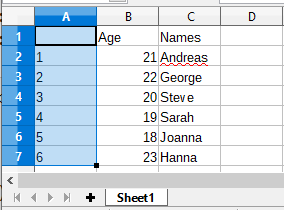
In the adjacent example we are going to requite the canvas another name and nosotros will set the row.names parameter to FALSE.
write.xlsx(df, 'names_ages.xlsx', sheetName = "Names and Ages", row.names=Simulated)
Lawmaking language: R ( r ) 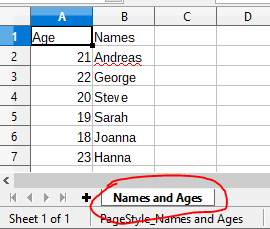
Equally can be seen, in the image above, we get a new sheet proper name and we don't take the indexes as a column in the Excel sheet. Annotation, if y'all get the error 'could non find office "write.xlsx"' it may be that you did not load the xlsx library.
Writing Multiple Pandas Dataframes to an Excel File:
In this section, nosotros are going to acquire how to write multiple dataframes to one Excel file. More specifically, we will apply R and the xlsx package to write many dataframes to multiple sheets in an Excel file.
Starting time, nosotros start past creating three dataframes and add them to a list.
df1 <-data.frame('Names' = c('Andreas', 'George', 'Steve', 'Sarah', 'Joanna', 'Hanna'), 'Age' = c(21, 22, 20, 19, 18, 23)) df2 <- data.frame('Names' = c('Pete', 'Hashemite kingdom of jordan', 'Gustaf', 'Sophie', 'Sally', 'Simone'), 'Age' = c(22, 21, xix, 19, 29, 21)) df3 <- data.frame('Names' = c('Ulrich', 'Donald', 'Jon', 'Jessica', 'Elisabeth', 'Diana'), 'Age' = c(21, 21, 20, xix, 19, 22)) dfs <- listing(df1, df2, df3)
Code language: R ( r ) Next, we are going to create a workbook using the createWorkbook function.
wb <- createWorkbook(type="xlsx")
Code language: R ( r ) Finally, nosotros are going to write a custom function that we are going to utilize together with the lapply office, subsequently. In the code chunk below,
add_dataframes <- function(i){ df = dfs[i] sheet_name = paste0("Sheet", i) canvas = createSheet(wb, sheet_name) addDataFrame(df, sheet=sheet, row.names=Faux) }
Code language: R ( r ) It's fourth dimension to employ the lapply function with our custom R function. On the second row, in the lawmaking chunk below, we are writing the workbook to an xlsx file using the saveWorkbook office:
lapply(seq_along(dfs), function(x) multiple_dataframe(x))saveWorkbook(wb, 'multiple_Sheets.xlsx')
Code linguistic communication: R ( r ) Summary: How to Work With Excel Files in R
In this working with Excel in R tutorial we have learned how to:
- Read Excel files and Spreadsheets using read_excel and read.xlsx
- Load Excel files to dataframes:
- Import Excel sheets and skip rows
- Merging many sheets to a dataframe
- Reading many Excel files into one dataframe
- Load Excel files to dataframes:
- Write a dataframe to an Excel file
- Creating many dataframes and writing them to an Excel file with many sheets

Source: https://www.marsja.se/r-excel-tutorial-how-to-read-and-write-xlsx-files-in-r/


0 Response to "How to Read Txt Files in R"
Post a Comment